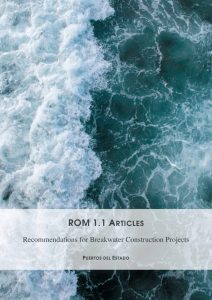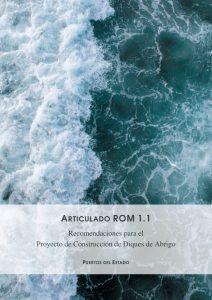Recommendations for Breakwater Construction Projects (ROM 1.1) completes the regulatory framework of Puertos del Estado for maritime infrastructures that protect land areas against marine dynamics (i.e. wave oscillations). It is a revision and expansion of the ROM 0.0-01 and ROM 1.0-09.
The methodology applied in the ROM 1.1 is described in the ROM 0.0-01. With all of its specificities, it reinforces and is the driving force behind the conservation, repair, readaptation and dismantling of port and maritime works. It also points to the need for experimental studies to verify Construction and Investment Projects (of whatever type) and to map out new basic research lines that will help to revise current recommendations and create new ones. The international prestige of the ROM program is an additional motivation to attain these objectives.
The basic premises of this methodology can be found in a wide range of books on reliability and risk theory as well as in numerous technical articles. The most relevant of these references are cited throughout this ROM and listed in one of the annexes.
When applying the ROM 1.1, it is advisable for engineers to be familiar with the recommendations of the ROM Program that are most closely related, particularly the ROM 1.0-09, ROM 2.0-11, ROM 3.1-99 and ROM 0.5-05. Furthermore, when applying the ROM 1.1 in Spain, engineers should also have an in-depth knowledge of the Método para la Evaluación de Inversiones Portuarias [Method for the Evaluation of Port Investments] or MEIPOR-16, published by Puertos del Estado and used to analyze the financial and economic profitability of port investments. Generally speaking, when the ROM 1.1 is applied outside of Spain, the investment evaluation method currently in force in that country should always be used. In all likelihood, it will not differ significantly from the MEIPOR-16 or the Guide to Cost-Benefit Analysis of Investment Projects of the European Union (CE, 2002) on which the MEIPOR-16 is based.
The ROM 1.1. should only be applied by expert engineers or under the supervision of senior engineers with many years of experience in the field of harbor and maritime works, coastal engineering, and offshore structures. Precisely for this reason, it is not a textbook to help users learn how to carry out a construction project. Instead, it is a text that guides and helps engineers to apply a methodology that they must first be familiar with. Accordingly, users of the ROM 1.1 and MEIPOR-16 should possess a solid background on numerical and statistical methods, risk and reliability, macroeconomy and coastal ecology as well as specific notions of coastal, port and maritime engineering, construction, and geotechnical engineering, as well as materials and atmospheric engineering.
The ROM 1.1 takes into account other recommendations of the ROM Program, but always avoiding any repetition or duplication. It is composed of the following documents: Articles and Manual for Breakwater Design and Guide for the Application of the ROM Articles and three annexes titled Technical Project Specifications, Characterization of Sea Oscillations, and Examples.


